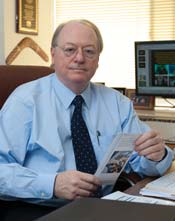Revisions needed for residents? Response to IOM report mixed
New IOM recommendations intended to improve patient care, resident education.
The Institute of Medicine’s recent recommendation that more steps are needed to ensure safer conditions for patients and trainees in teaching hospitals has proved controversial.
Issued by the IOM’s Committee on Optimizing Graduate Medical Trainee (Resident) Hours and Work Schedules to Improve Patient Safety, the recommendation is the first since 2003 when the initial set of national work hour limits for residents in all specialties came from the Accreditation Council for Graduate Medical Education (ACGME).
In this new IOM report, the recommendation to further adjust resident work hours is intended to accomplish three objectives: “to prevent fatigue when possible by giving regular opportunities for recovery sleep; to lessen fatigue when residents work extended shifts or night shifts; and to give training hospitals some flexibility in scheduling to provide residents the intensive, in–depth patient care experiences while enhancing a culture of patient safety and health care quality,” said Michael M.E. Johns, MD, chair of the IOM committee and chancellor of Emory University in Atlanta.
The IOM report does not recommend further reductions from the maximum average of 80 hours per week set by the ACGME, but it does recommend that the maximum number of hours that residents can work without time for sleep be set at 16, that the number of days residents must have off be increased, and that restrictions be set on moonlighting during residents’ off-hours.
Have reduced hours worked?
Duty hour restrictions were prompted in part by the death of patient Libby Zion in 1984. Her death was attributed to an adverse drug reaction allegedly missed by a fatigued resident. Although a grand jury investigation did not provide convincing evidence that work hours played a role, there was a perceived need to help prevent medical mishaps that could be linked to exhausted trainees.
Since the ACGME issued its restrictions, several studies have evaluated the effect of those changes on patient safety and mortality.
One study, published in The Journal of the American Medical Association, found that restricted work hours at VA hospitals were associated with lower mortality rates in patients with acute MI, congestive HF, gastrointestinal bleeding or stroke, or a diagnosis-related group classification of general, orthopedic or vascular surgery.
A second study, also published in JAMA, showed that in the first two years of implementation, the reduced working hours neither worsened nor improved mortality for Medicare patients.
Implementation should vary
Flexibility and adaptation are key to successful implementation of the IOM recommendations, according to David F. Dinges, PhD, professor and chief of the division of sleep and chronobiology at the University of Pennsylvania.
|
Photo by: Dan Burke |
“It should not be assumed that one prescriptive formula will solve every problem ... that all specialties are the same and that what is good for surgery will be good for internal medicine and so forth,” Dinges said.
Although limiting hours is a critical component of the recommendations, not all health care professionals are convinced that further limiting hours is the only answer. Carl J. Pepine, MD, professor of medicine at the University of Florida and chief medical editor of Cardiology Today, said that more and better supervision is also vital to improving training and reducing errors during training and after training is completed.
One concern he voiced was the increasing trend toward less peer-related checks among trainees. “We used to have a pyramid of trainees, so you maybe had 50 interns, 30 first-year residents, 20 second-year residents, 10 third-year residents with two chief residents who had completed residency and one to two fellowship years of training,” Pepine said. “So a pyramid of people, at various skill levels, were supervising the lesser-trained individuals in addition to an attending and many times even the patient's personal physician.”
Pepine said that every case was presented multiple times at multiple levels. Continuity of care, considered essential for optimal care, seems to have “completely disappeared among physicians-in-training. Just how trainees will learn this, if ever, is unknown. How this will effect errors and optimal care in their future practices is unknown,” he said
A fellow’s perspective
Juan Rivera, MD, a fellow at the Johns Hopkins Ciccarone Center for Prevention of Heart Disease, said that interrupting the night call to go to sleep can diminish essential experiences.
|
|
“It’s completely unreal to say, ‘well, it’s time for me to go to sleep, someone else is going to take care of this,’” Rivera said. “It cuts from what the experience should be; a good number of complications, learning experiences, happen in the middle of the night.
“The training culture has to change,” Rivera said. “We have to adopt a more multidisciplinary approach, a group approach as opposed to the intern or resident taking care of everything. I just don’t think that going to sleep in the middle of the call night will help training. I am more in favor of reducing the hours with no protected sleep.”
Early this month, the ACGME will hold a conference with leaders in graduate medical education to review the IOM report and discuss possible revisions to the duty hour standards. – by Christen Haigh

For more information:
- Ann Intern Med. 2004;140:814-815.
- BMJ. 2003;327:E88-E89. Institute of Medicine of the National Academies – Resident Duty Hours: Enhancing Sleep, Supervision and Safety – Public Briefing: http://www.www8.nationalacademies.org
- Institute of Medicine of the National Academies – Resident Duty Hours: Enhancing Sleep, Supervision and Safety – Reports: http://www.iom.edu
- JAMA. 2007;298:1055-1057.
- JAMA. 2007;298:984-992.
- JAMA. 2007;298:975-983.
- N Engl J Med. 2004;351:1838-1848.
- N Engl J Med. 2008; DOI:10.1056/NEJMp0808736. Accessed Dec. 10, 2008.
- Public Library of Science, 2006; DOI:10.1371/journal.pmed.0030487. Accessed Jan. 12, 2009.


